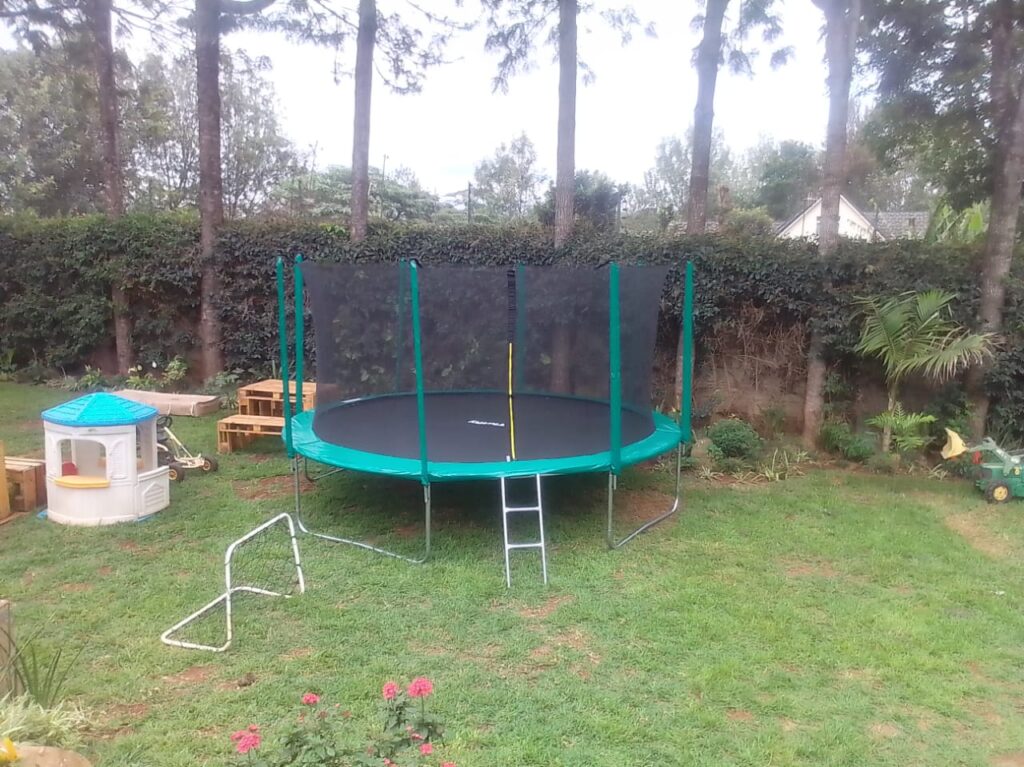Parts of a Trampoline in Kenya

When you’re engrossed in the sheer delight of bouncing on a trampoline in Nairobi Kenya , it’s easy to forget about the materials that make it possible. But have you ever pondered what trampolines are constructed from and which particular parts contribute to that exhilarating bounce you adore? Lets explore the main parts of a trampoline
Parts of a Kenyan trampoline comprise four fundamental components:
- Springs
- Tubing
- Safety Pads
- Canvas Fabric
Springs :The source of a trampoline’s bounce lies in its springs rather than the canvas surface, as commonly believed. The springs produce the force that propels you into the air. Nonetheless, the strength of a spring is determined by five key factors: material composition, galvanization, size, quantity, and shape.
Material: The power of trampoline springs is closely linked to the material used in their construction. While metal is the standard choice for most trampolines, some backyard models opt for elastic bands as a spring alternative. However, unlike metal springs, these bands lose tension and bounce potential over time.
One way manufacturers can enhance the durability of metal springs is through galvanization. This process involves applying a layer of zinc coating to the spring, which provides a protective barrier against corrosion. Zinc is much more resistant to rust and deterioration than other metals, like steel. By using galvanized springs, trampoline manufacturers can ensure that their products remain sustainable and long-lasting.
Size: A trampoline’s buoyancy depends on its spring’s size. The greater spring length enables the application of increased force, resulting in a higher bounce.
Number: The comfort and performance of a trampoline are directly impacted by the quantity of springs it possesses. With an increase in the number of springs, weight distribution becomes easier and greater force can be applied.
Shape: When building a trampoline, tapered springs are the preferred choice. Despite being pricier than other spring types, their superior quality is worth it. They offer greater lateral stability to the jumper.
Tubing: Trampolines are constructed using tubing for the frame and legs, which can vary in size depending on the trampoline model. From personal fitness trampolines to large indoor ones, there is a wide range of sizes available, and the tubing is cut accordingly based on the intended purpose of the trampoline. Despite the variation in size, all tubing pieces are galvanized to prevent rust and deterioration, as previously mentioned.
Safety Pads: Safety pads provide a cushioned surface for safe jumping on a trampoline, as the name suggests. They are typically placed over both the springs and the frame and are made of vinyl covers filled with plush foam. The density of the foam can vary depending on the manufacturer and the intended use of the trampoline. For instance, indoor trampoline parks may use the maximum amount of foam to ensure the safety of children playing on the trampoline.
The primary function of these pads is to protect the jumper from injury, as falls are common on trampolines. Since the trampoline frame is typically made of exposed steel, safety pads are a standard safety protocol for most trampoline manufacturers to prevent serious injuries to jumpers.
Canvas Fabric
The top surface of the trampoline is covered with a canvas fabric, commonly referred to as a “jumping mat,” which is composed of interwoven polyethylene or nylon fibers. These fibers are knitted together to create a flat canvas sheet that is subsequently affixed to the trampoline frame. The primary function of the jumping mat is to provide a landing surface for jumpers while distributing the bounce area across the underlying springs.


